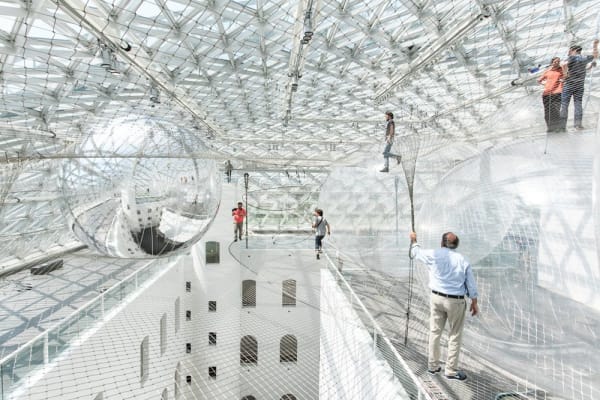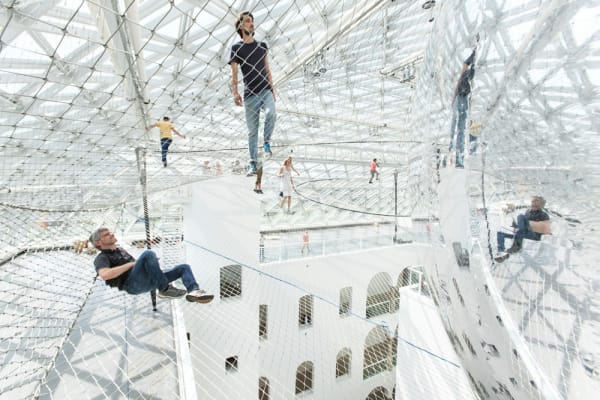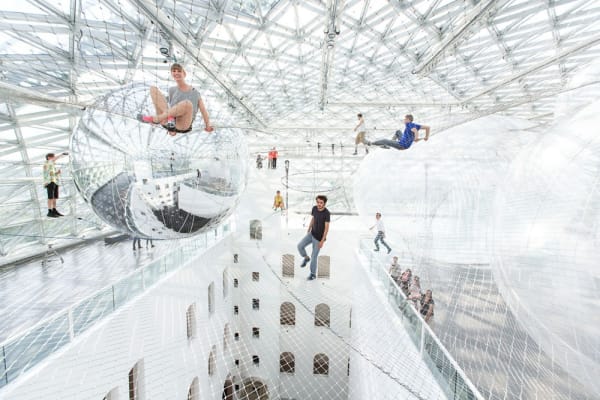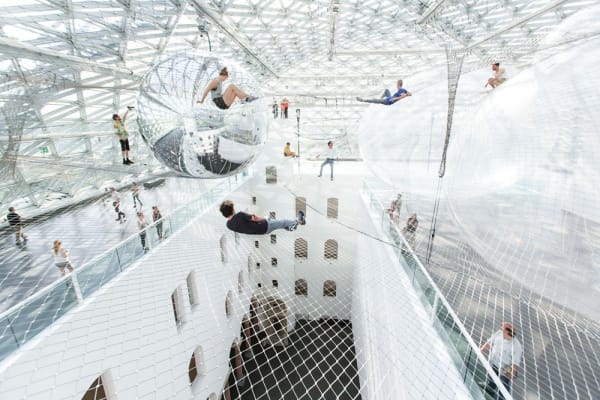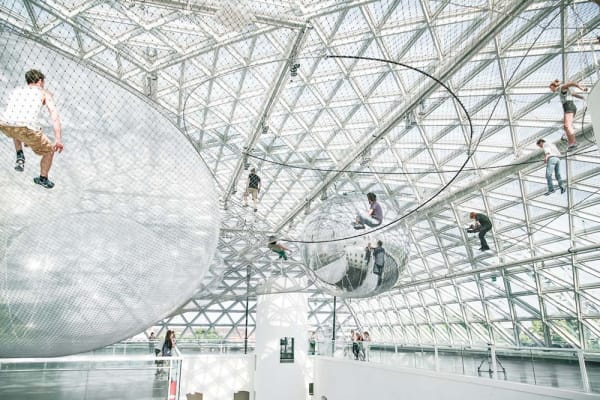TOMÁS SARACENO: IN ORBIT: KUNSTSAMMLUNG NORDRHEIN-WESTFALEN, K21 STÄNDEHAUS, DÜSSELDORF
Suspended at a height of more than 25 m above the piazza of K21 is the enormous installation in orbit, a work by the artist Tomás Saraceno. The installation appears as a surreal landscape, and is reminiscent of a sea of clouds or floating planetary bodies. The physically accessible work is constructed of virtually transparent steel mesh that interlaces three levels spanning the massive glass dome. Five air-filled “spheres” are positioned within the net structure that encompasses an area of 2500 m².
Visitors are invited to enter the installation, and explore it by climbing. The brave ones who venture into the structure look upon museum visitors down below, wandering in the piazza, as miniature figures that occupy a miniature-like world. From the ground floor and the mezzanines of the Ständehaus, the installation’s visitors on the net look like floating in the sky.
Once several people enter the structure simultaneously, it is set to motion, altering the tension of the steel cables and distances between the three levels of the interlaced net. The floating space now becomes a vibrating web of relationships, resonances, and synchronous communication.
Like a spider in a web, visitors perceive the presence of others through vibrations. This echoes Saraceno's interest and research, carried in his studio in Berlin, on new hybrid and more-than-human forms of communication, and co-habitation.
In terms of scale and discourse, in orbit is at forefront of Saraceno's oeuvre. Even those who are reluctant to enter the structure, suspended high above an abyss, and who decide instead to explore the installation in exclusively visual terms, will find themselves confronted with themes of flying, falling, and floating, and gripped by archetypal emotions that are associated with these experiences.
"To describe the work means to describe the people that use it – and their emotions," explains Saraceno. Rarely does a work of art touch fears and desires of viewers so intensely, and alters the perspectives of those who decide to step into an airborne condition.
in orbit was planned by Saraceno together with engineers, architects, and biologists from 2011 to 2013, and it is one of the artist’s most elaborate installations. Despite the fact that the network construction alone weighs three tons, and the largest of the "spheres" 300 kg, the work, created specially to the spatial condition of the Ständehaus with a meticulous precision, is remarkably light: its fineness and stability hints to the structure of a spider's web.
For a number of years, the artist has been inspired by the intricate construction of spider webs, and has assembled the first three-dimensional hybrid spider web collection in the world. His research, intrigued by more-than-human worlds, studies web-building techniques and social group behavior of various spider species. The results of this inquiry have enriched his artistic practice by incorporating the insights on the functionality, beauty, and strength of the webs into his works.
While the precise observation of nature and natural phenomena suggests the basis for Saraceno’s work, art-historical references, like of visionary architects Frei Otto or Richard Buckminster Fuller, are recognizable as well. Saraceno’s practice can be viewed as a constant research and ambition to propose and to realize utopian architecture that is well informed by environmental, social and mental ecologies. Each installation, including in orbit, is a step forward to this large-scale visionary project, with an ultimate result: a floating city of the future.
Perceived as a response to the current troubling environmental crisis, the vision materializes in multiple recent actions, gathered together under the Aerocene project: experiments in science, community building and social engagement, performances and interdisciplinary dialogues, inviting to fly and float with one’s feet on the ground.
